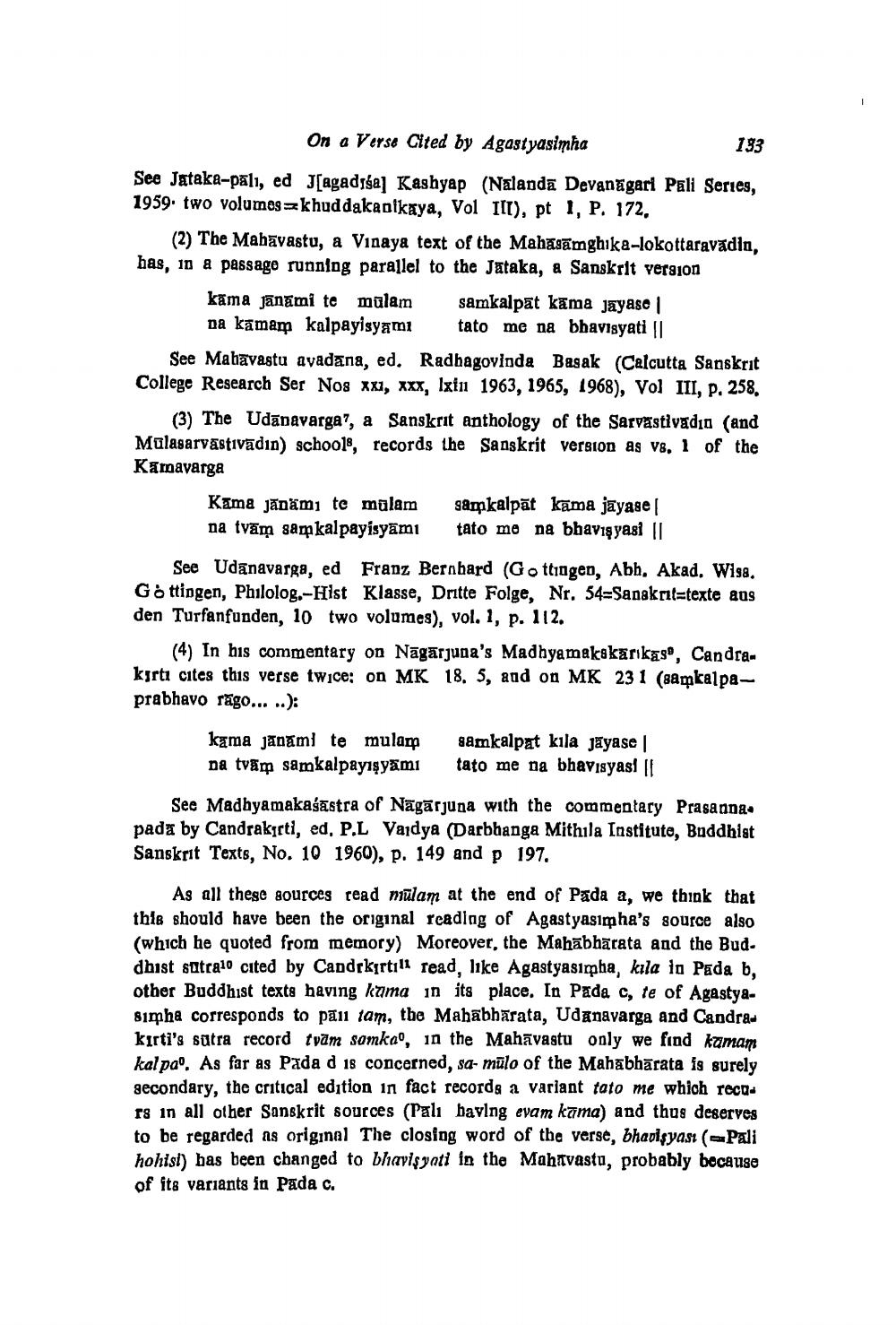________________
On a Verse Cited by Agastyasimha
193
See Jataka-pali, ed Jagadīša] Kashyap (Nalanda Devanagari Páll Series, 1959. two volumes khud dakaplkaya, Vol Ilt), pt 1, P. 172,
(2) The Mahāvastu, a Vinaya text of the Mahajamghika-lokottaravadin, has, in a passage running parallel to the Jutaka, a Sanskrit version
kama janami te mulam Samkalpat kama jayase 1
na kamam kalpayisyami tato me na bhavisyati || See Malavastu avadana, ed. Radhagovinda Basak (Calcutta Sanskrit College Research Ser Nos xx, xxx, lxiu 1963, 1965, 1968), Vol III, p. 258.
(3) The Udāpavarga?, a Sanskrit anthology of the Sarvastivadia (and Mulasarvastivādın) schools, records the Sanskrit version as v8. 1 of the Karavarga
Kama jānami te mulam sampkalpāt kama jayase na tvām sapkalpayisyāmi tato me na bhaviş yasi ||
See Udanavarga, ed Franz Bernhard (Gottingen, Abh. Akad. Wisa. Go ttingen, Philolog.-Hist Klasse, Dritte Folge, Nr. 54=Sanakrit=texte aus den Turfanfunden, 10 two volumes), vol. 1, p. 112.
(4) In his commentary on Nāgārjuna's Madhyamakskarikaso, Candrakyrtı cites this verse twice: on MK 18. 5, and on MK 231 (sapkalpaprabhavo rago... ..):
kama janami te mulam na tvám samkalpayışyämi
Samkalpat kila jāyase | tato me na bhavisyasi il
See Madhyamakaśāstra of Nāgārjuna with the commentary Prasanna pada by Candrakirti, ed, P.L Vaidya (Darbhanga Mithila Institute, Buddhist Sanskrit Texts, No. 10 1960), p. 149 and p 197.
As all these sources read mulam at the end of Pada a, we think that this should have been the original readlag of Agastyasipha's source also (which he quoted from memory) Moreover, the Mahābhārata and the Bud. dhist satralo cited by Capdrkirtill read, like Agastyasipha, kila in Pada b, other Buddhist texts having kuma in its place. In Pada c, te of Agastyasimha corresponds to pau tam, the Mahābhārata, Udanavarga and Candrakirti's satra record tväm samkao, in the Mahavastu only we find kamam kal pa. As far as Pada d 18 concerned, sa- mūlo of the Mahabhārata is surely gecondary, the critical edition in fact recorda a variant tato me which reco18 in all other Sanskrit sources (Palı having eyam kama) and thus deserves to be regarded as original The closing word of the verse, bhavisyası (Pali hohist) has been changed to bhavisyati in the Mahnvasta, probably because of its variants in Pada c.




